2013 Yamaha FX SHO Review
Go ahead, call it a musclecraft
Yamaha’s FX SHO is arguably the brand’s musclecraft flagship. Though the FZR, FZS, or even the VXR models may seem more truly race-inspired, the FX SHO is the model that packs the performance punch and the big hull feel that typically epitomizes the muscle genre. Tweaks last season have even improved its stature.
Fly Like a Butterfly, Sting Like a Bee
We’ll put the amenities on hold for a minute. After all, power and handling are often the factors that make or break a muscler.
RESEARCH: Read all our Yamaha WaveRunner reviews
The power source is no surprise, Yamaha’s familiar 1.8-liter engine. In its SHO, or Super High Output mode, it features both a supercharger and intercooler to further pump up the performance. Top speed, with a light load and good conditions, is the gold standard 65 mph. The low-end punch en route is strong enough to rocket you out of the hole in that impromptu grudge match, or rocket your friend out of the hole on a slalom water ski. I also continue to notice a nice midrange punch, great for powering out of a turn.
It’s an engine that has a well-deserved reputation. It’s reliable and tough, equally at home in saltwater or fresh. It’s also one that, unlike some high-end mills, still happily runs on 87-octane pump gas.
The ride that engine powers is arguably even more thrilling than generations past. In 2012 Yamaha tweaked the tried-and-true FX formula, mostly in the name of comfort. But the changes – a longer hull, redesigned chines – have awakened new, improved handling within. Crank the FX into a turn, adjust your body weight in an intuitive, inside lean fashion (but keep that outside, back foot solidly planted), and you’ll carve with almost utter precision. Almost completely gone is the FX’s former tendency to feel a little jerky in turns, likely the result of the hull falling off the running pad and onto the chines. Instead, it now displays almost a graceful, sweeping transition, with the ability to bite sharply where desired.
COMPETITION: Read our review of the Kawasaki Jet Ski Ultra 300X
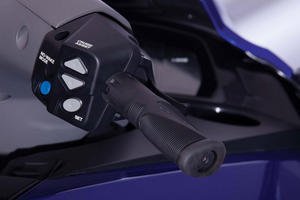 Want to cruise in comfort? Selecting a steady cruising speed is as simple as pressing a button.
Want to cruise in comfort? Selecting a steady cruising speed is as simple as pressing a button.Enhance those manners with Yamaha’s manual trim. Five preset positions, accessed via a twist knob on the left handgrip, allow the driver to drop the bow for corners, and raise it upon exit, or when wanting to trim up for the best possible top speed. The manual system allows you to keep your eyes on the water and feel your way through the positions. That’s a plus. Not always so appreciated is the fact that it’s harder to trim a manual system than an electronic, as that twist of your wrist is literally fighting the thrust exiting the nozzle. At high speed, it can be difficult unless you briefly chop the throttle before switching.
More Bang…and Comfort…for the Buck
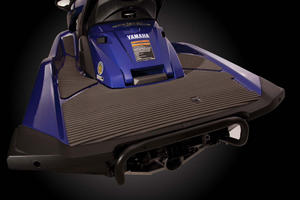 A larger rear platform makes getting onto the craft from the water much easier.
A larger rear platform makes getting onto the craft from the water much easier.I alluded to recent tweaks to the FX platform. They enhance a number of areas. One is simple length. Starting in 2012, the FX grew by about 7 ½ inches in length. About half of that room went to seat length, making passengers feel less crowded in the saddle. The other half went to the aft boarding platform. The extra space works in conjunction with a redesigned boarding step. It’s flat across the bottom (more comfortable and stable than round, especially on bare feet), and works in conjunction with an additional handhold at platform height to let riders climb aboard, almost ladder style, rather than muscle themselves up onto the craft.
Other ergonomic changes include a repositioning of the mode buttons for the info display. They’re now directly in front of the saddle, rather than forward of the handlebars, making using them substantially easier.
And then there are the cosmetic enhancements that change the shape of the craft. By bolting panels in specific places, Yamaha has given the FX an edgier facelift without retooling an entire deck mold. That keeps the craft’s looks fresh. Those panels, however, can also have fringe benefits. Aft, a panel under the saddle creates room for a small, wet storage compartment. It’s great for waterski towropes, snorkel and masks, and other gear that may be too damp for the main storage. A nice touch is a cutout in the door; it allows a towrope to stay hooked up to the tow eye, even with the door closed.
And then there’s the saddle. Designed to allow a little more movement for the driver than a Cruiser-style seat, it doesn’t offer the severe bolsters the latter has made famous. It does, however, ramp upwards to give each successive passenger a better view forward, as well as snug them more securely in their individual spots.
COMPETITION: Read our review of the Sea-Doo RXP-X 260
The most compelling feature, however, is likely Yamaha’s mechanical neutral. By building a detent into the throw of the reverse lever, and incorporating a window indicator to let you know when you’ve hit the right spot, Yamaha has effectively given the FX a simple neutral without going to the extent of electronic trickery. Riders can now start the craft in a stationary position at the dock or ramp, before shifting into forward or reverse. It’s a bulkier solution, certainly, but a simple, cost-effective one. (But yes, reverse is still located to starboard. If you’re buying a Yamaha, you just better get used to the idea of not being able to conveniently use throttle while in reverse.)
So what’s left? Stuff that by now should be quite familiar. Cruise control and no-wake mode are a given with electronic throttle. Lock a comfortable speed in for longer-distance cruising, and then just fully squeeze the throttle, eliminating pressure off a single finger. Up-down arrow keys allow fine-tuning within a roughly 10 mph span. No-wake does likewise, but requires no throttle pressure at all. The FX SHO also continues to use the Yamaha security remote. Like an automotive key fob, it clicks a lockout feature into action to prevent unauthorized use. It can also be used to activate a governed speed setting, reducing the engine’s power output for either gas savings, or when entrusting the craft to a less-experienced rider.
Tilt steering allows riders to fine tune their position, whether short or tall, seated or standing.
In short, this is a pretty full-featured, pretty fast, pretty imposing machine on the water. Or, just what you would probably expect from a flagship muscler.
| 2013 Yamaha FX SHO Specs | |
| Length | 130.2 inches |
| Beam | 48.4 inches |
| Dry Weight | 851 lbs |
| Engine | Supercharged w/intercooler 4-cylinder EFI |
| Displacement | 1,812 cc |
| Bore and Stroke | 86mm x 78mm |
| Compression Ratio | 8.6:1 |
| Rated Horsepower | N/A |
| Fuel Capacity | 18.5 gal. |
| Combined Stowage Capacity | 33.2 gal. |
| Colors | Deep Blue or Black |
| Price | $14,299 |
Get PersonalWatercraft.com in your Inbox!
Like PersonalWatercraft.com on Facebook
Comments
Most Popular

2025 Yamaha JetBlaster PRO 2-Up Review

2024 Kawasaki Jet Ski STX 160X Review

Remembering the Sea-Doo XP

Whatever Happened to the Wetbike?

2025 Yamaha JetBlaster Review




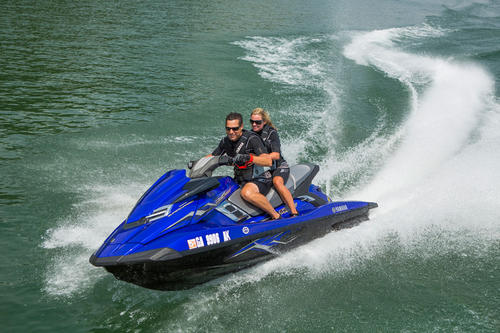
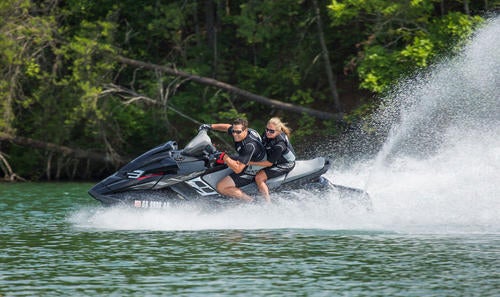
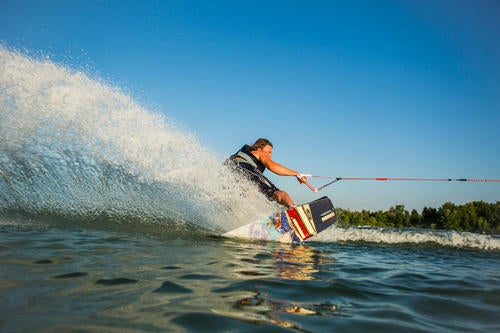
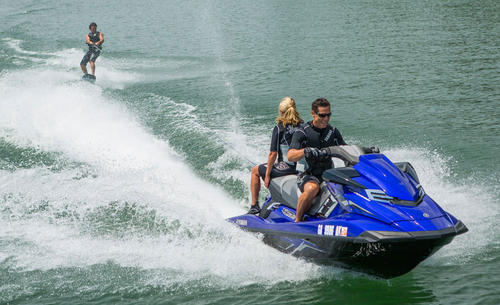
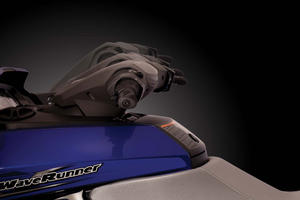







 Your Privacy Choices
Your Privacy Choices